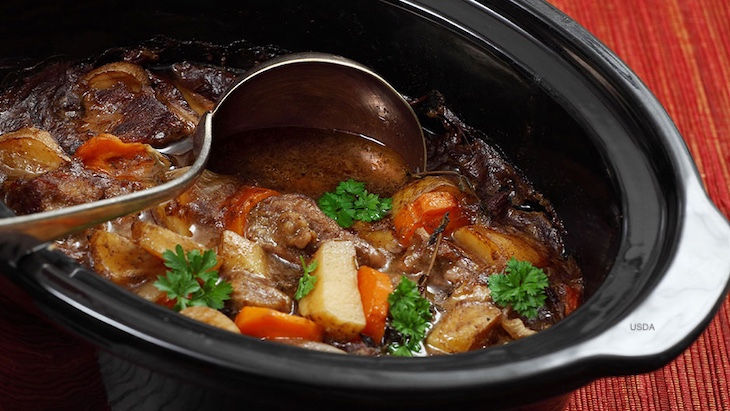Learn about slow cooker food safety with tips from the USDA. Slow cookers are appliances that cook food at lower, but still safe, temperatures, for long periods of time. The food heats up quickly enough to stay safe, but cooks long enough to make tougher ingredients such as cheaper cuts of meat and root vegetables tender over time.

There are several appliances that function as slow cookers: The traditional slow cooker, the instant pot, and some pressure cookers that have slow-cook functions. While these appliances are easy to use, there are some rules you need to follow to make sure your food is safe to eat.
First, if you plan to use frozen meat, seafood, or poultry, do not add it to the slow cooker when frozen. Thaw it first before adding it to the slow cooker. Do not thaw frozen food on the counter, but put it in the refrigerator overnight, or thaw it in cold water. You can also thaw frozen food in the microwave oven, but that food needs to be cooked immediately.
Rinse fresh fruits and vegetables in the kitchen sink before cutting them or adding them to the slow cooker. When you cut up vegetables for your meal, keep raw meat, poultry, and seafood separate from any foods that you will eat raw, such as garnishes. Use separate cutting boards, plates, and utensils for each.
Large cuts of meat and poultry can be safely cooked in the slow Coker. But, make sure that your particular model can be used to cook these larger pieces. Do not cook stuffed chicken or turkey in the slow cooker.
Vegetables, especially root vegetables, cook more slowly than meats and poultry, and should be place on the bottom of the appliance. Cut all vegetables to about the same size so they cook evenly and at the same time.
Make sure that the slow cooker is filled one-half to two-thirds full. If it’s too full, the slow cooker may overflow as liquid is released from food as it cooks and there is little evaporation, or the food may be undercooked. If it isn’t full enough, the food may burn.
Start the slow cooker as soon as you have finished prepping the food. Do not use a timer to make the slow cooker start at a later time, since bacteria can quickly multiple in foods that are sitting at room temperature for more than two hours. And while you may assume that your meal is safe to eat because it has cooked for hours, the only way to know for sure is to use a food thermometer. Put the thermometer in the thickest part of the food, avoiding bone, fat, or gristle if you are checking meat.
Finally, refrigerate leftovers within two hours of cooking (one hour if the ambient air temperature is above 90°F). Divide large amounts of food into smaller containers and chill immediately. Then wash your slow cooker insert with hot, soapy water, or put it into the dishwasher if it is dishwasher safe.




